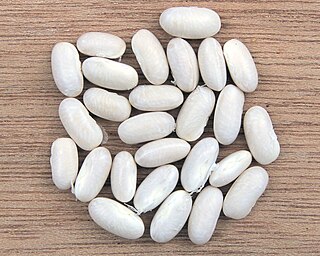
A bean is the seed of several plants in the family Fabaceae, which are used as vegetables for human or animal food. They can be cooked in many different ways, including boiling, frying, and baking, and are used in many traditional dishes throughout the world.
Calypso, Calipso, Kalypso, Kalipso, may refer to:

Phaseolus is a genus of herbaceous to woody annual and perennial vines in the family Fabaceae containing about 70 plant species, all native to the Americas, primarily Mesoamerica.

Legumes are plants in the family Fabaceae, or the fruit or seeds of such plants. When used as a dry grain for human consumption, the seeds are also called pulses. Legumes are grown agriculturally, primarily for human consumption, but also as livestock forage and silage, and as soil-enhancing green manure. Well-known legumes include beans, chickpeas, peanuts, lentils, lupins, mesquite, carob, tamarind, alfalfa, and clover. Legumes produce a botanically unique type of fruit – a simple dry fruit that develops from a simple carpel and usually dehisces on two sides.

Phaseolus acutifolius, also known as the tepary bean, is a legume native to the southwestern United States and Mexico and has been grown there by the native peoples since pre-Columbian times. It is more drought-resistant than the common bean and is grown in desert and semi-desert conditions from Arizona through Mexico to Costa Rica. The water requirements are low. The crop will grow in areas where annual rainfall is less than 400 mm (16 in).

Phaseolus coccineus, known as runner bean, scarlet runner bean, or multiflora bean, is a plant in the legume family, Fabaceae. Another common name is butter bean, which, however, can also refer to the lima bean, a different species.

Phaseolus vulgaris, the common bean, is a herbaceous annual plant grown worldwide for its edible dry seeds or green, unripe pods. Its leaf is also occasionally used as a vegetable and the straw as fodder. Its botanical classification, along with other Phaseolus species, is as a member of the legume family, Fabaceae. Like most members of this family, common beans acquire the nitrogen they require through an association with rhizobia, which are nitrogen-fixing bacteria.
Red bean is a common name for several plants and may refer to:

Green beans are young, unripe fruits of various cultivars of the common bean, although immature or young pods of the runner bean, yardlong bean, and hyacinth bean are used in a similar way. Green beans are known by many common names, including French beans, string beans, and snap beans or simply "snaps." In the Philippines, they are also known as "Baguio beans" or "habichuelas" to distinguish them from yardlong beans.
Black bean commonly refers to:

The navy bean, haricot bean, pearl haricot bean, Boston bean, white pea bean, or pea bean is a variety of the common bean native to the Americas, where it was first domesticated. It is a dry white bean that is smaller than many other types of white beans, and has an oval, slightly flattened shape. It features in such dishes as baked beans, various soups such as Senate bean soup, and bean pies.
Feijao is derived from feijão, the Portuguese word for bean. It most commonly refers to:
P. vulgaris may refer to:
Colin Louis Avern Leakey was a leading plant scientist in the United Kingdom, a Fellow of King's College, Cambridge and of the Institute of Biology, and a world authority on beans.

Phaseolin is a prenylated pterocarpan found in French bean seeds and in the stems of Erythrina subumbrans.

Epigeal germination is a botanical term indicating that the germination of a plant takes place above the ground. An example of a plant with epigeal germination is the common bean. The opposite of epigeal is hypogeal.
Pea beans are several types of common food plants producing beans:
Paraheliotropism refers to the phenomenon in which plants orient their leaves parallel to incoming rays of light, usually as a means of minimizing excess light absorption. Excess light absorption can cause a variety of physiological problems for plants, including overheating, dehydration, loss of turgor, photoinhibition, photo-oxidation, and photorespiration, so paraheliotropism can be viewed as an advantageous behavior in high light environments. Not all plants exhibit this behavior, but it has developed in multiple lineages.









